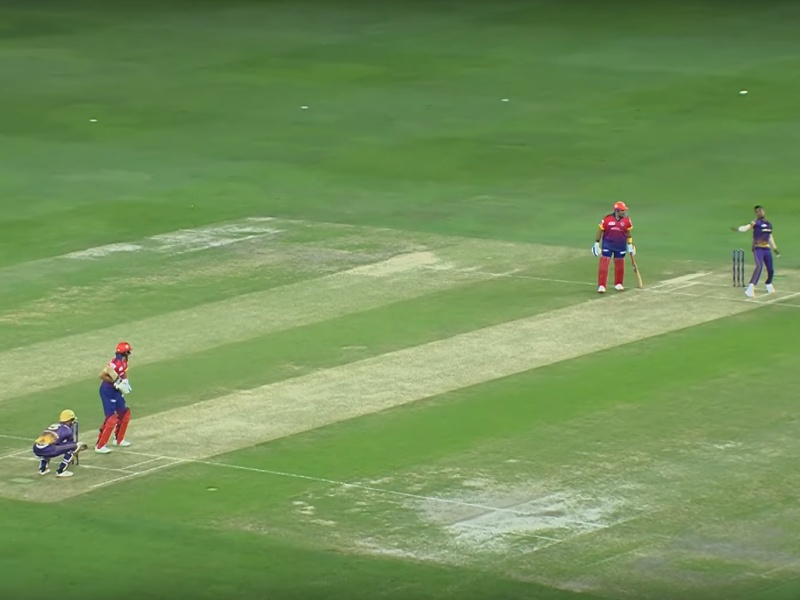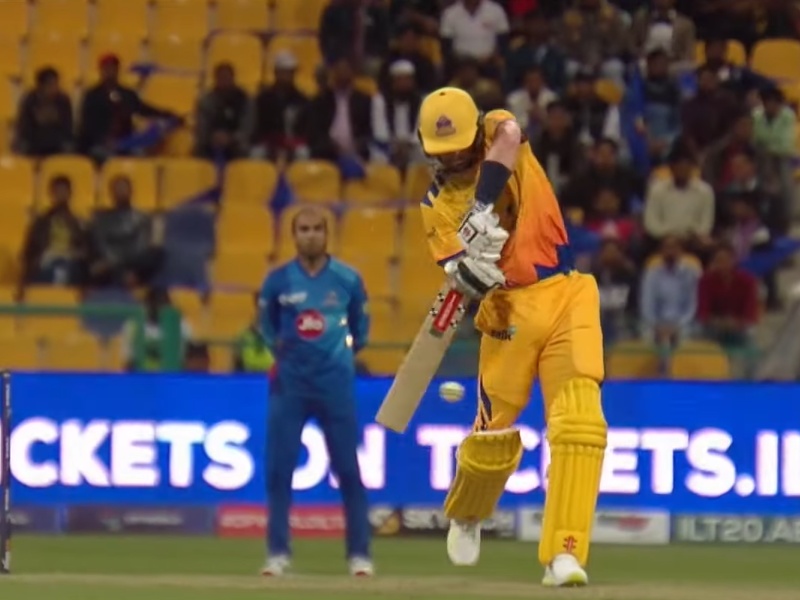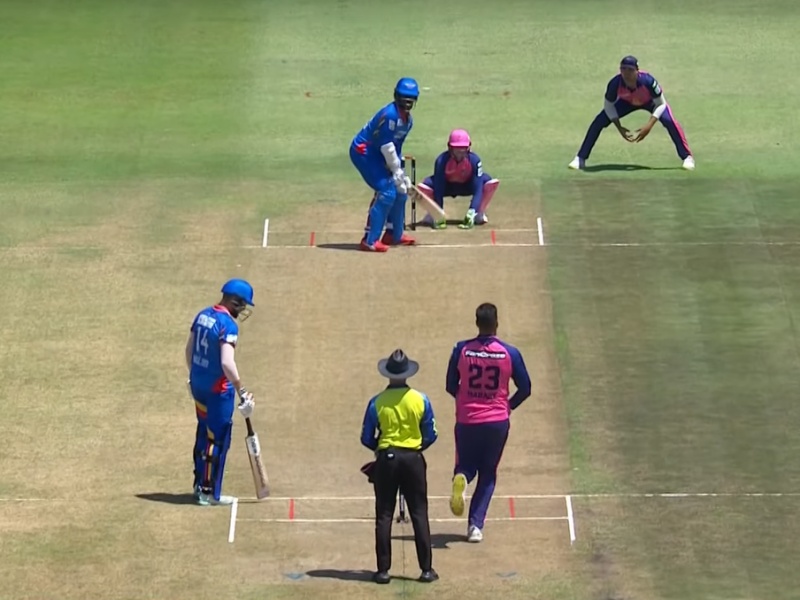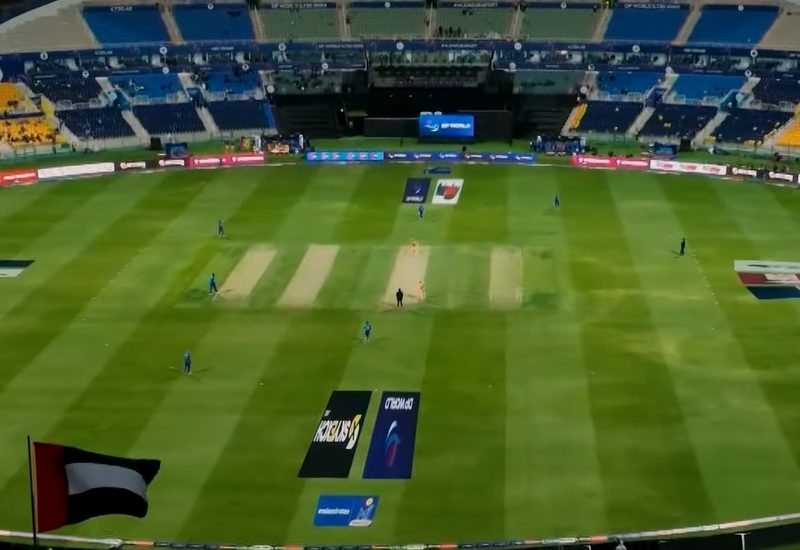There are an awful lot of T20 franchise leagues these days. It’s hard to keep up. If you want to work out whether a new one is worth following, the absolute last thing you’d want to do is actually watch a match. So is there a quicker and easier way to measure the quality of a given league?
Back in August, we wrote a piece headlined ‘How popular are all these Not-Quite-The-IPL franchise leagues actually likely to be?‘ The boiled-down jus of the article is that most T20 leagues aren’t all they’re cracked up to be. Not even close. There is in fact a massive excess of cracking-up going on and a correspondingly large volume of failing to meet up to expectations.
With the BBL, BPL, ILT20 and SA20 all currently underway, these are things we’re thinking about a lot right now.
The photo
It all kind of came to a head with a photo of Joe Root. In the photo, Root is playing a reverse sweep while playing for Dubai Capitals with Abu Dhabi Knight Riders wicketkeeper Connor Esterhuizen looking on. What struck us was how familiar it all looked.
Root is obviously a very familiar figure, but his clothes were familiar too. They were basically the Delhi Capitals kit. Esterhuizen’s kit was even more familiar as it was the hugely distinctive gold and purple of Kolkata Knight Riders.
So everything was familiar and yet any conclusions we might foolishly have drawn from that familiarity would have been wrong.
Here we had two teams consciously and explicitly shaped as paler facsimiles of franchises who themselves only retain a certain fraction of their playing staff from year to year anyway. It’s hard to get a toehold in this kind of world. In terms of identity, we’re talking a bunch of freelancers temporarily rallied round a photocopied flag.
Just to underline that fact, when we went looking for the photo just now, we commenced our search in the SA20, which turned out to be completely the wrong league.
Seriousness

Dubai Capitals v Abu Dhabi Knight Riders didn’t, to us, feel like a serious match. We have no doubt that those running the two franchises have put a lot of thought into shaping their squads and that they’ve done the best they can given monetary and availability constraints.
However, when you survey the resultant teams with no knowledge of that process, you could be forgiven for thinking the league had instead opted for the good old-fashioned names-out-of-a-hat system. (Not necessarily such a terrible thing. We’ve advocated for the hat in the past.)
If we’ve added up right (no guarantees) then Dubai Capitals fielded international cricketers from seven different nations. This is no mean feat, but it’s also a measure of how widely the net’s been spread. That approach gives you players like Bhanuka Rajapaksa, Sikandar Raza and Akif Raja. We’ve always loved Ravi Bopara, but he has been younger – so too Robin Uthappa and Yusuf Pathan.
Root’s there, Rovman Powell’s got a bit of T20 pedigree, but things tail off pretty quickly after that. What we’ve been wondering is whether there’s a really quick way to measure that without even reading through the whole team sheet? (Yes, we are very lazy. What of it?)
Where the lack-of-quality shines through

We’ve been wondering whether you can look at the two players in a particular slot on the scorecard in a given match and immediately draw pretty accurate conclusions about the whole league.
At this point we must guilitily inform you that we have no answers here, only scrawled-on-a-beermat thinking-out-loud.
If you manage to secure the services of a great batter, you’ll tend to stick them up the order to get good use out of them. Opening bowlers will often be big names too. When squads are thin, that must leave holes elsewhere. But where exactly? Number six batters maybe? Fifth bowlers? We’re not sure.
Number sixes?
If we take this option, Dubai Capitals v Abu Dhabi Knight Riders gives us Yusuf Pathan and Andre Russell. Pathan may be 40, but Russell’s presence does actually suggest a pretty decent standard of cricket.
Last night’s match between Sharjah Warriors and Desert Vipers gives us Joe Denly and Benny Howell, which is a little less good and also quite geographically misleading.
In the SA20, last night’s Durban Super Giants v Paarl Royals match gives us Dwaine Pretorious and Dane Vilas. Familiar names at least and indicative of a league with a more local hue.
For the most recent match in the BBL, Melbourne Stars v Brisbane Heat, we get Nathan Coulter-Nile and Jimmy Peirson.
In the BPL Dhaka Dominators v Sylhet Strikers gives us Nasir Hossain and Thisara Perera.
Fifth bowlers?

T20 bowling order is a lot less formulaic than in the longer formats. Captains are far more likely to mix things up, opening with a spinner or whatever. Fifth bowler feels to us like the most likely purveyor of the kind of no-man’s land overs when the powerplay has finished and before things kick off at the finish.
Dubai Capitals v Abu Dhabi Knight Riders gives us Sunil Narine and Sikandar Raza, which even if Narine isn’t quite the bowler he was, doesn’t feel representative of the match as a whole.
Sharjah Warriors v Desert Vipers gives us Rohan Mustafa and Mohammad Nabi, which is closer but does also make us want to watch the ILT20 a bit because… Mohammad Nabi.
Durban Super Giants v Paarl Royals gives us Evan Jones and Dwaine Pretorius, which actually feels about right as a flavour of that match and league.
Melbourne Stars v Brisbane Heat gives us Mitchell Swepson and Clint Hinchcliffe, which is pretty good too.
Dhaka Dominators v Sylhet Strikers gives us Thisara Perera and Nasir Hossain (the same two who were batting at number six, funnily enough).
Alternatives?
What these examples suggest is that there isn’t perhaps one particular playing role where weaker players are generally hidden. It also gives no sense of players who might be phoning it in. It doesn’t tell you if a player’s only around for three matches before jetting off to a totally different league.
However, what it does make us think is that if you picked one of these roles, or something similar, it wouldn’t take too many games to get a real feel for the depth in quality in a given league.
The two roles above are just our initial ideas. There are probably better metrics for measuring the same thing and we’re open to suggestions. The key is that it shouldn’t involve analysis; it should be quick and dirty and provide you with an instant gut reaction.
How would you measure the quality of a T20 league?
Get the King Cricket email and treat yourself to a fractionally more entertaining inbox some of the time.




I suspect that some people might offer the view that the ‘Anywhere Aardvarks vs Regional Rhinos’-style interchangeability and the lack of identity is inherent to a franchised, auction-driven league model: the players are fungible (for a given level of ‘star power’), the locations are fungible, the team names/colours are fungible – only the spectators give a sense of the games taking place in a particular location in space and time.
Others might say that actually a team identity can be crafted out of little more than a sponsor’s name or logo and a period of success – look at Team Sky in cycling, Red Bull in Formula 1, and so on. And even the likes of Liverpool FC were upstart latecomers at one point in time, the thing about history is that you can’t create it all at once.
I think on balance I’d be more in the former camp than the latter.
Team Sky were an interesting one because they just about passed themselves off as a team people supported while their lead riders were British. But really, from a fan’s perspective, cycling is an individual sport and as soon as the team was being led by Richard Carapaz or Egan Bernal, all the previous supporters kind of melted away.
“Is there a quick and easy way to judge the quality of a franchise match?”
No.
Marcus Trescothick was chosen as a specialist subject on tonight’s Mastermind.
Questions included the name of the village where he got married.
The amount of work that went into this analysis is impressive. However, I am easily impressed.
You’re in the right place.
One of the pictures in the article has a slip fielder with his hands behind his back. A damning indictment.
I am not sure a thorough analysis is merited – most of these leagues will go on for a couple of years and then be later disbanded or downgraded to local competitions (not necessarily a bad outcome, mind you). The problem with T20 seems to be that it is fast exhausting the possible means by which it can guarantee excitement. 45 runs needed in two overs? Done. 250+ total in 20 overs? Done. Damsels in short skirts waving pom-poms? Done. Scores tied and a super over? Done and done. A more pressing question would be what these leagues can do to still stay relevant. The answer, sadly, is quite clear: fuck all.
The premise of the article is really, ‘how can we very quickly do an anything-but-thorough analysis?’
Did I tell everyone to watch out for Rwanda’s Henriette Ishimwe at the U19 T20 World Cup in a comment on a previous article? Yes I did!
Can’t find any footage of her two wickets in Rwanda’s one-run win over Ireland in the warm-up matches, but here’s Henriette Ishimwe’s double hat-trick as Rwanda achieved their first ever victory at a global ICC tournament with a 39-run win over Zimbabwe. Now very likely Rwanda will reach the Super Six stage, although given the bizarre nature of this tournament’s Super 6- it isn’t a round robin, since the top-ranked teams avoid playing each other while the teams that sneak in as third in their groups don’t get the chance to nick points off each other either – it’s almost inconceivable, having lost to Pakistan and likely losing to England on Thursday, that Rwanda could progress from the Super 6.
https://www.icc-cricket.com/video/3025420
To be fair it’s not a very strong Zimbabwe team so an upset was always possible. They managed to lose twice to Indonesia in the warm-up matches, first by 1 wicket and then by 15 runs in the replay. Then in the first match of the tournament proper, scored 25 runs against England off 12 overs to fall to a 174-run defeat. But whoever it’s against, you’d take a World Cup double hat-trick on your CV, wouldn’t you?
You’re slightly undermining your Nostradamus tipping performance by using the term ‘double hat trick’ you know.
In a partial (idiosyncratic) answer to the “shallowness of franchise matches” question, I find a tournament such as the U19 Women’s World Cup orders of magnitude more interesting than franchise tournaments.
Achievements by Henriette Ishimwe and a youthful Rwanda team has meaning to me, whereas just another T20 (or Hundred) franchise/match is so much “so what”.
To be fair on Bail-out, btw, the Aussie commentator on the Rwanda match refers to the four-in-four exclusively as a double-hat-trick.
Golf has albatrosses, eagles, birdies, par, bogie and double bogie. Surely cricket can support more terms than just confusing variants of ‘hat trick’?
https://www.zerowicket.com/the-ten-greatest-double-hat-tricks-in-history-cricket-15471/
Agree it needs a better name. But it does seem to be the name. Goodness knows what it gets called when someone takes two separate hat-tricks in an innings, or manages that elusive six wickets in six balls…
That’s a magnificent phrase. It should be used to replace all corporate taglines. Starbucks – a bunch of freelancers temporarily rallied round a photocopied flag. Accenture – a bunch of freelancers temporarily rallied round a photocopied flag. Amazon… you get the idea.
In fact, when I am in charge I will make this THE LAW.
10-15 years ago it felt like T20 franchise leagues were the future of cricket. Now I’m much less sure. Part of the problem is that there is nothing organic about the emergence of these teams or leagues – they were originally just the creation of overseas investors and now are basically just tendrils of the IPL. They have no roots in any sort of fan or amateur player community and so their entire existence feels contrived (which it is) for Indian TV and gambling markets.
The IPL and BBL have done a reasonably good job of ensuring some sense of team identity has emerged, by having the same core of players and largely allowing the same franchises to exist for an extended period. Other leagues do not have this advantage and seem to be in constant flux, existing for a matter of months of even weeks and then fading away, ready to be reconstituted or not next year.
This is why it struck me as mad that the ECB mimicked the franchise model for The Hundred. It’s not a style of competition that’s well-embedded in English sports culture and doesn’t even work all that well, outside the IPL and BBL.